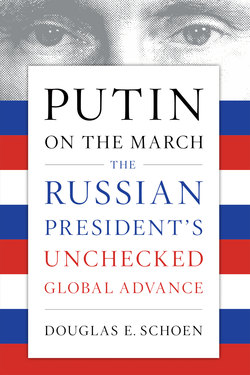Читать книгу Putin on the March - Douglas E. Schoen - Страница 7
На сайте Литреса книга снята с продажи.
ОглавлениеCHAPTER ONE
Russia’s Ongoing Aggression
As we argued in Putin’s Master Plan, Russia works relentlessly to undermine NATO, destabilize Europe and America, dominate the Middle East, and project its power around the globe, in a way that some argue makes it even more dangerous than the Soviet Union was during the Cold War. From Ukraine to Syria, from the Baltics to the Balkans, Putin presses forward aggressively in order to restore what he feels is Russia’s rightful status as the superpower dominating Europe, Asia, and even further afield. Consider his moves in Syria, his continued menacing of Ukraine, his serial violations of the Intermediate-Range Nuclear Forces, or INF, Treaty, and even his brazen penetrations of American airspace and sea lanes in the Atlantic. Such provocations follow a concerted strategy, and all of them will worsen without a coherent, strategic American response.
There is little sign that what many now regard as a Putin victory in Ukraine will be reversed or even contained. In May 2017, Putin and German chancellor Angela Merkel met and pledged to push to finalize the Minsk accords—the 2015 deal stipulating ceasefire terms in Eastern Ukraine, which are still on the table but no closer to fruition. Talk is cheaper than ever. The fighting continues.
In January 2017, more than thirty died in a clash between the Ukrainian army and pro-Russia rebels in the town of Avdiivka. Ominously, both sides used weapons banned under the ceasefire terms. Both accused the other of instigating the violence. The Organisation for Security and Co-Operation in Europe called the fighting the heaviest in a year.
“The current escalation in Donbass is a clear indication of Russia’s continued, blatant disregard of its commitments under the Minsk agreements with a view of preventing the stabilization of the situation,” reads a statement from Ukraine’s foreign ministry.1 Plans were discussed for evacuating the sixteen thousand residents of Avdiivka, where electricity and other utilities had been knocked out.
The attack came as the new Trump administration was reportedly considering lifting economic sanctions against Russia imposed by President Obama. At the time of this writing, Congress has defied the president and moved to stiffen sanctions. As Ukraine’s president, Petro Poroshenko, put it, “The shelling is massive. Who would dare talking about lifting the sanctions in such circumstances? What additional proof is needed to bring the aggressors to justice?”2
In Eastern Ukraine especially, the ravages of war are felt. “Hundreds of thousands of people are living under the perpetual threat of shelling, shooting, and land mines. Their access to basics like food, water, and electrical power has been dramatically curtailed,” said Peter Maurer, president of the International Committee of the Red Cross.3
CNBC’s Dina Gusovsky identified four key groups fighting in Ukraine on behalf of Putin’s aims: “Pro-Russian Ukrainians,” who had backed the former pro-Moscow president Viktor Yanukovych; “Mercenaries paid by Russian interests, including ethnic Chechens”; Russian separatists; and Russian special forces, which, according to her reporting, “are on the ground in Ukraine and have been for months.”4 Moscow denies these claims, but its past denials—about “little green men,” for example—have been widely debunked by news reports and international observers.
There is no question that, over the last several years, Putin has moved decisively toward victory in Ukraine. In the Donbas region, for example, schools are now closely following Russian educational standards, commerce is carried out in rubles, and Putin recently issued a decree recognizing passports and other documents issued by the separatist governments in Luhansk and Donetsk—which, in March 2017, seized control of about forty Ukrainian companies.5 Critics point out that the Ukraine struggle has become enormously costly to Putin, and this is true; but my sense here is, again, that we are measuring Putin’s operations by conventional Western standards of self-interest. By Putin’s reckoning, what he has gained and stands to gain is worth the cost.
That same kind of thinking guides Putin’s brazen efforts in Syria—another pursuit that, years ago, he was told was futile, wasteful, and against his own national self-interest by American diplomats like Obama’s secretary of state, John Kerry. He didn’t listen, seeing a crucial opportunity in Syria to expand Russia’s military presence beyond its own waters—indeed, the Russian maritime strategy for 2020 stresses the “need to reestablish a permanent Russian Navy presence in the Mediterranean.”6 Thanks to an October 2016 treaty deal between Moscow and Damascus, Russia also established its first permanent air base in the Middle East. Moscow boasted that the new air defenses would be able to fight off a US airstrike; its forces were authorized to “shoot to kill” in such a scenario. In July 2017, Putin signed an agreement with Syria ensuring that Russia can keep the air base operating in Syria for nearly a half-century.7
Despite ongoing deescalation talks—and his pledged support for deescalation—Putin is clearly engaged in bombing efforts against rebel-held areas in Syria. Russian warplanes have waged a bombing campaign against US-supported opposition groups in Syria, even as Moscow claims that its military campaign in the country has formally concluded. On the contrary: Evidence shows that the Russians are reengaging militarily in Syria. In October 2016, Russian and Syrian warplanes pummeled opposition forces in Aleppo for a solid month. Observers described the bombing as the most intense since the start of the conflict; it killed more than 440 civilians, including 90 children, according to the Syrian Observatory for Human Rights.8 As a result of the Aleppo bombing, Washington suspended its plans to coordinate with Russia on counterterrorism strikes in Syria. In response, Putin withdrew from an arms-control agreement that required both the United States and Russia to dispose of thirty-four tons of plutonium.
